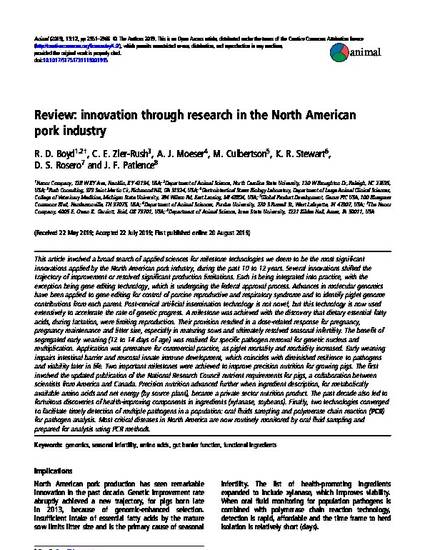
This article involved a broad search of applied sciences for milestone technologies we deem to be the most significant innovations applied by the North American pork industry, during the past 10 to 12 years. Several innovations shifted the trajectory of improvement or resolved significant production limitations. Each is being integrated into practice, with the exception being gene editing technology, which is undergoing the federal approval process. Advances in molecular genomics have been applied to gene editing for control of porcine reproductive and respiratory syndrome and to identify piglet genome contributions from each parent. Post-cervical artificial insemination technology is not novel, but this technology is now used extensively to accelerate the rate of genetic progress. A milestone was achieved with the discovery that dietary essential fatty acids, during lactation, were limiting reproduction. Their provision resulted in a dose-related response for pregnancy, pregnancy maintenance and litter size, especially in maturing sows and ultimately resolved seasonal infertility. The benefit of segregated early weaning (12 to 14 days of age) was realized for specific pathogen removal for genetic nucleus and multiplication. Application was premature for commercial practice, as piglet mortality and morbidity increased. Early weaning impairs intestinal barrier and mucosal innate immune development, which coincides with diminished resilience to pathogens and viability later in life. Two important milestones were achieved to improve precision nutrition for growing pigs. The first involved the updated publication of the National Research Council nutrient requirements for pigs, a collaboration between scientists from America and Canada. Precision nutrition advanced further when ingredient description, for metabolically available amino acids and net energy (by source plant), became a private sector nutrition product. The past decade also led to fortuitous discoveries of health-improving components in ingredients (xylanase, soybeans). Finally, two technologies converged to facilitate timely detection of multiple pathogens in a population: oral fluids sampling and polymerase chain reaction (PCR) for pathogen analysis. Most critical diseases in North America are now routinely monitored by oral fluid sampling and prepared for analysis using PCR methods.
Available at: http://works.bepress.com/john-patience/105/

This article is published as Boyd, R. D., C. E. Zier-Rush, A. J. Moeser, M. Culbertson, K. R. Stewart, D. S. Rosero, and J. F. Patience. "Innovation through research in the North American pork industry." animal 13, no. 12 (2019): 2951-2966. doi:10.1017/S1751731119001915.